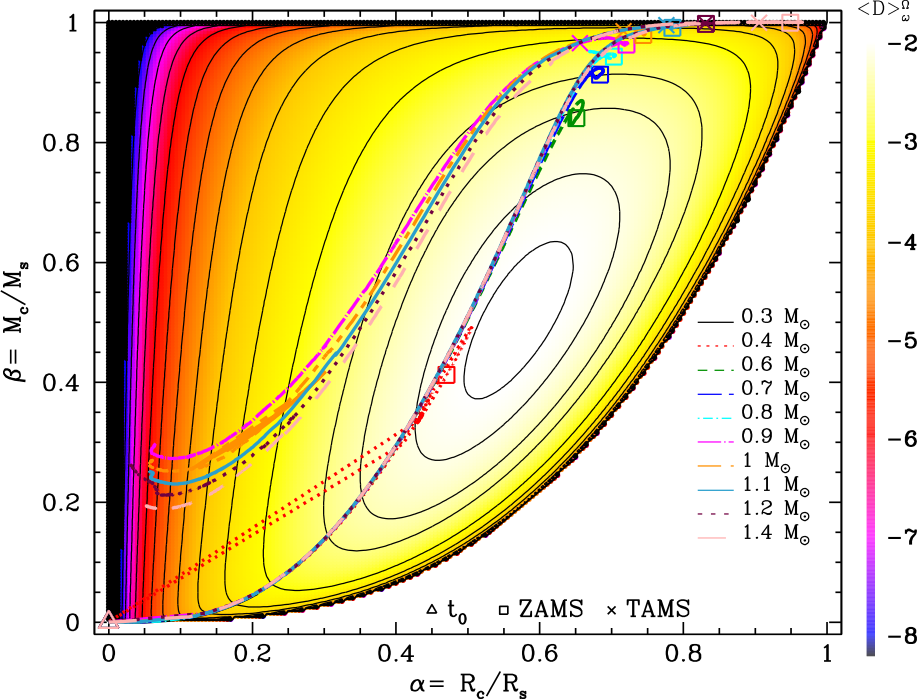
Tidal HRD from Gallet et al. (2017)
Tidal dissipation in rotating low-mass stars
and implications for the orbital evolution of close-in planets
I. From the PMS to the RGB at solar metallicity
F. Gallet, E. Bolmont, S. Mathis, C. Charbonnel, and L. Amard
Abstract
Close-in planets represent a large portion of the population of confirmed exoplanets. To understand the dynamical evolution of these planets, star-planet interactions must be taken into account. In particular, the dependence of the tidal interactions on the structural parameters of the star and its rotation should be treated in the models. We estimate how the tidal dissipation in the convective envelope of rotating low-mass stars evolves as a function of their mass, evolutionary phase, and rotation rate from the pre-main sequence up to the red-giant branch at solar metallicity. We also investigate the possible consequences of this evolution on planetary orbital evolution. We couple the method described in Mathis (2015) to the stellar evolution code STAREVOL for rotating stars ranging from 0.3 to 1.4 M⊙. In addition, we also generalize the work of Bolmont & Mathis (2016) by following the orbital evolution of close-in planets using these new tidal dissipation predictions for advanced phases of stellar evolution. While during the pre-main sequence the evolution of tidal dissipation is controlled by the evolution of the internal structure of the star through the stellar contraction, on the main-sequence this dissipation is strongly shaped by the evolution of the surface rotation, itself impacted by the stellar winds. The main effect of including rotation is to lower the tidal dissipation by about four order of magnitude on the main-sequence. The evolution of the dissipation strongly depends on both the evolution of the internal structure and rotation of the star. During the lifetime of the star, it varies over several orders of magnitude, which has a strong consequence for the orbital evolution of close-in massive planets. These effects are the strongest during the pre-main sequence, which means that the planets are mainly sensitive to the star's early rotation history.
ReadMe.dat
Column 1: Logarithm of the time in yr
Column 2: Stellar luminosity (L☉)
Column 3: Stellar effective temperature (K)
Column 4: Stellar radius (R☉)
Column 5: β = Mass aspect ratio = Mcore/M★
Column 6: α = Radius aspect ratio = Rcore/R★
Column 7: Surface rotation rate of the star (days). Initial rotation = 1.4 days (5.20e-05 s-1)
Column 8: Logarithm of the frequency averaged tidal dissipation (see Eq. 1 of paper I)
Column 9: Logarithm of the modified equivalent quality factor (see Eq. 5 of paper I)
Column 10: Logarithm of the structural frequency-averaged tidal dissipation (see Eq. 3 of paper I)
Column 11: Logarithm of the structural modified equivalent quality factor (see Eq. 6 of paper I)
0.3 M⊙ M_03_Z_0134.csv
0.4 M⊙ M_04_Z_0134.csv
0.6 M⊙ M_06_Z_0134.csv
0.7 M⊙ M_07_Z_0134.csv
0.8 M⊙ M_08_Z_0134.csv
0.9 M⊙ M_09_Z_0134.csv
1.0 M⊙ M_10_Z_0134.csv
1.1 M⊙ M_11_Z_0134.csv
1.2 M⊙ M_12_Z_0134.csv
1.4 M⊙ M_14_Z_0134.csv
Donwload all: AllDissip.tar.gz
These are condensed grids for which we selected 500 points at most to allow a good description of the full raw tracks. The discription of these 500 points can be found in Lagarde, N., Decressin, T., Charbonnel, C., et al. 2012, A&A, 543, A108 (PDF)
The full grids can be retrieved by sending a request.
Last update: January 18 2019
